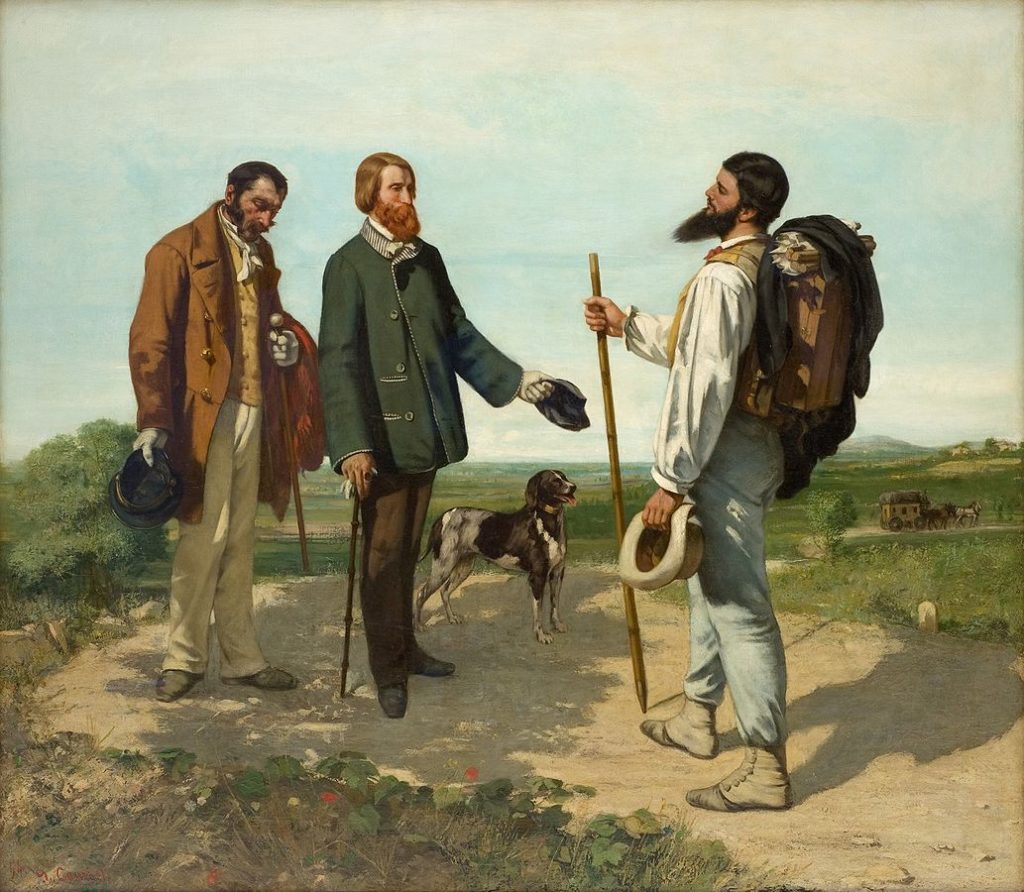The Meeting (or ‘Bonjour, Monsieur Courbet’)
I remember first seeing an image of this in E. H. Gombrich’s Story of Art, which was my bible while studying Art History at college. I found the painting intriguing and appealing without really thinking about why, and I didn’t quite see how Courbet fitted into an otherwise neat chronology that the author had compiled. He was obviously doing something different to everyone else, breaking with what he saw as the outmoded and restrictive norms of the time, which I guess is part of its charm.
The Meeting (or ‘Bonjour, Monsieur Courbet’) (1845) is essentially a group portrait, though the title and composition give it a narrative. The spontaneity of the composition suggests a chance meeting, where the artist is greeted by friends while out in the countryside. Courbet is the rather dashing figure on the right hand side, and it is in fact his patron, Alfred Bruyas, whom he has met, with his servant and dog either side of him. Courbet is out in nature, perhaps seeking a worthy subject for his next painting. Unlike most art of the period the subject matter is not derived from romantic literature, nor is it an idealised view of a classical theme. Realism, which Courbet pioneered, urged artists depict the everyday and declared it worthy of the status of history painting – regarded the highest of subjects. The standards of the acclaimed French Salon were being seriously challenged, there was a uprising that called for art to be truly modern. Fuelled by such prolific writers as Emile Zola, Honore de Balzac and Charles Baudelaire, Courbet wrote a Realist Manifesto, stating that he wanted to create art “to translate the customs, the ideas, the appearance of my epoch according to my own estimation.”
Courbet was seen as an avant garde artist, very much doing his own thing regardless of how it would be received. In the same year he painted this work he wrote “I hope always to earn my living by my art without having ever deviated by even a hair’s breadth from my principles, without having lied to my conscience for a single moment, without painting even as much as can be covered by a hand only to please anyone or sell more easily.” I think that defiance and conviction comes across in his work. The fact that he has depicted himself dressed down in white shirtsleeves (something no self-respecting artist would do) was shocking to the audience when first exhibited in 1855. Courbet has not paid homage to the rules of Academic art in terms of theme, composition, colour or beauty. He is going his own way, and there are those (including Bruyas) who recognise his genius for doing so.
Courbet was one of the first truly modern artists. He pioneered what was then a revolutionary thought that we take for granted: that personal expression and individuality was the very purpose of being an artist, and that it was more important than tradition.

